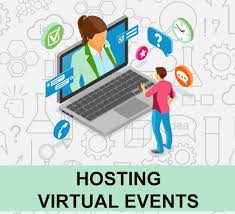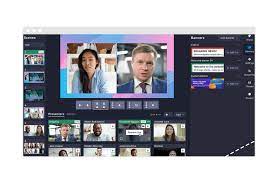Unlocking the Potential of Virtual Event Solutions
In today’s digital age, virtual events have become an essential part of our professional and personal lives. With the global shift towards remote work and social distancing, businesses and individuals are embracing virtual event solutions to connect, engage, and collaborate.
Virtual event solutions offer a wide range of benefits that traditional in-person events simply cannot match. From cost savings to increased accessibility, here are some compelling reasons why virtual events are gaining popularity:
Cost Savings
One of the most significant advantages of virtual events is cost savings. Hosting an in-person event requires substantial investments in venue rentals, travel expenses, catering services, and more. Virtual events eliminate these costs by providing a platform for participants to attend from anywhere in the world without the need for physical infrastructure.
Global Reach
With virtual event solutions, geographical barriers are no longer a limitation. Participants can join from different time zones and locations, expanding your event’s reach to a global audience. This opens up opportunities for networking, knowledge sharing, and collaboration on an international scale.
Flexibility and Convenience
Virtual events offer unparalleled flexibility and convenience for both organizers and attendees. Participants can access sessions or presentations at their convenience, eliminating scheduling conflicts or travel constraints. Additionally, organizers can easily record sessions for later viewing or provide on-demand content to extend the lifespan of their event.
Enhanced Engagement
Contrary to popular belief, virtual events can foster high levels of engagement. Interactive features such as live chat rooms, Q&A sessions, polls, and surveys enable real-time interaction between participants and speakers. Virtual event platforms also provide analytics tools that allow organizers to measure engagement levels and gather valuable insights.
Eco-Friendly Approach
By eliminating the need for physical travel and reducing carbon emissions associated with large-scale events, virtual event solutions contribute to a more sustainable future. Going virtual aligns with the growing emphasis on corporate social responsibility and environmental consciousness.
As virtual event solutions continue to evolve, so do the possibilities for creating immersive and engaging experiences. From virtual trade shows and conferences to webinars and product launches, the potential applications are vast.
However, it’s important to choose the right virtual event platform that aligns with your specific requirements. Factors such as scalability, security measures, customization options, and technical support should be carefully considered when selecting a solution.
In conclusion, virtual event solutions offer a multitude of benefits that empower businesses and individuals to connect and collaborate in innovative ways. By embracing this digital transformation, organizations can unlock new opportunities for growth while adapting to the changing landscape of events in today’s interconnected world.
9 Advantages of Virtual Event Solutions: From Cost Savings to Immersive Experiences
- Cost savings compared to in-person events
- Global reach and audience expansion
- Flexibility and convenience for participants
- Extended event lifespan through on-demand content
- Enhanced engagement with interactive features
- Real-time interaction through live chat and Q&A sessions
- Measurable analytics for insights and improvement
- Eco-friendly approach by reducing carbon emissions
- Opportunities for innovative and immersive experiences
Four Downsides of Virtual Event Solutions: Navigating Technical Hurdles, Networking Limitations, Engagement Difficulties, and Diminished Emotional Impact
- Technical Challenges
- Limited Networking Opportunities
- Potential Engagement Issues
- Reduced Emotional Connection
Cost savings compared to in-person events
One of the standout advantages of virtual event solutions is the significant cost savings they offer compared to traditional in-person events. By eliminating expenses associated with venue rentals, travel arrangements, catering services, and other logistical requirements, virtual events provide a more budget-friendly alternative. This cost-effectiveness allows businesses and individuals to allocate their resources more efficiently and reach a wider audience without compromising on the quality of their event experience. Virtual events truly revolutionize the event industry by enabling organizations to achieve their goals while keeping costs under control.
Global reach and audience expansion
One of the key advantages of virtual event solutions is the ability to reach a global audience and expand your event’s reach beyond geographical limitations. With virtual events, participants from different time zones and locations can easily join, allowing for international networking, knowledge sharing, and collaboration. This global reach opens up new opportunities for businesses and individuals to connect with a diverse audience, fostering cross-cultural exchange and expanding their professional networks on a global scale.
Flexibility and convenience for participants
One of the key advantages of virtual event solutions is the flexibility and convenience they offer to participants. With virtual events, attendees have the freedom to access sessions, presentations, and networking opportunities at their own convenience. This eliminates the need for rigid schedules and allows individuals to fit event participation into their busy lives. Whether it’s joining a live session or accessing on-demand content later, virtual events provide a level of flexibility that accommodates diverse schedules and time zones. This convenience empowers participants to engage with the event on their terms, ultimately enhancing their overall experience.
Extended event lifespan through on-demand content
One of the key advantages of virtual event solutions is the ability to extend the lifespan of an event through on-demand content. Unlike traditional in-person events that have a limited duration, virtual events allow organizers to record sessions, presentations, and discussions for later viewing. This means that attendees can access the content at their convenience, even after the event has ended. By providing on-demand access to valuable information and resources, virtual event solutions enable participants to continue engaging with the content long after the live sessions have concluded, maximizing the impact and value of the event.
Enhanced engagement with interactive features
One of the standout advantages of virtual event solutions is the ability to enhance engagement through interactive features. Unlike traditional in-person events, virtual events offer a range of interactive tools such as live chat rooms, Q&A sessions, polls, and surveys. These features enable real-time interaction between participants and speakers, fostering meaningful discussions and active engagement. Attendees can actively participate in sessions, ask questions, share opinions, and provide feedback. This level of interactivity not only keeps participants engaged throughout the event but also creates a sense of community and connection among attendees. With virtual event solutions, organizers can truly elevate the participant experience by incorporating interactive elements that encourage collaboration and knowledge sharing.
Real-time interaction through live chat and Q&A sessions
One of the significant advantages of virtual event solutions is the ability to facilitate real-time interaction through live chat and Q&A sessions. Unlike traditional in-person events, where participants may hesitate to ask questions or engage with speakers, virtual events provide a comfortable and inclusive environment for attendees to actively participate. Through live chat and Q&A sessions, participants can ask questions, share insights, and engage in meaningful discussions with speakers and fellow attendees. This interactive element enhances engagement, fosters knowledge sharing, and creates a sense of community even in a virtual setting.
Measurable analytics for insights and improvement
One significant advantage of virtual event solutions is the ability to gather measurable analytics that provide valuable insights and opportunities for improvement. With virtual events, organizers can track attendance rates, session engagement levels, participant feedback, and more. These analytics provide a comprehensive understanding of participant behavior and preferences, allowing organizers to make data-driven decisions to enhance future events. By analyzing these metrics, identifying areas of success or areas that need improvement becomes easier, leading to more effective event planning and execution in the future.
Eco-friendly approach by reducing carbon emissions
One significant advantage of virtual event solutions is their eco-friendly approach, which helps reduce carbon emissions. By eliminating the need for physical travel and large-scale event infrastructure, virtual events contribute to a more sustainable future. This aligns with the growing emphasis on corporate social responsibility and environmental consciousness. With virtual events, participants can engage in meaningful discussions and collaborations without leaving their homes or offices, making a positive impact on the environment by reducing their carbon footprint.
Opportunities for innovative and immersive experiences
One of the major benefits of virtual event solutions is the vast opportunities they provide for creating innovative and immersive experiences. With advanced technologies such as virtual reality (VR) and augmented reality (AR), organizers can design interactive environments that engage participants in entirely new ways. From virtual booths and product demos to gamified experiences and virtual networking, virtual event solutions offer endless possibilities for pushing the boundaries of traditional events. By harnessing these technologies, organizers can captivate attendees, deliver memorable experiences, and leave a lasting impact that goes beyond what is achievable in a physical setting.
Technical Challenges
One significant challenge associated with virtual event solutions is the potential for technical issues. Relying heavily on technology, virtual events can be susceptible to problems like poor internet connectivity, software glitches, or compatibility issues. These technical challenges can disrupt the event experience for both organizers and attendees, leading to frustration and a loss of engagement. It is crucial for organizers to have contingency plans in place and ensure that their chosen virtual event platform is reliable and well-supported to mitigate these potential disruptions.
Limited Networking Opportunities
One con of virtual event solutions is the limited networking opportunities they offer. While virtual events provide avenues for interaction, they may not fully replicate the organic networking experiences of in-person events. Building meaningful connections and fostering spontaneous conversations can be more challenging in a virtual setting. The absence of face-to-face interactions and physical presence can sometimes hinder the natural flow of networking, making it harder to establish deep connections and forge new relationships. However, with careful planning and the integration of interactive features, organizers can still create engaging networking environments that facilitate meaningful connections in the virtual realm.
Potential Engagement Issues
One potential drawback of virtual event solutions is the possibility of engagement issues. While virtual events offer interactive features, there is a risk that participants attending remotely may become distracted or engage in multitasking. This can hinder their level of engagement and active participation in the event. To overcome this challenge, organizers need to carefully plan and implement innovative strategies to keep attendees fully engaged throughout the event. This may involve incorporating interactive elements, creating compelling content, and leveraging technology to encourage active participation and minimize distractions.
Reduced Emotional Connection
While virtual event solutions offer numerous advantages, it’s important to acknowledge one potential drawback: reduced emotional connection. In-person events have the power to create a strong bond between participants through shared experiences and personal interactions. Unfortunately, virtual events may lack this immersive atmosphere, making it more challenging to establish deep connections or leave a lasting impact on attendees. The absence of physical presence and face-to-face interactions can diminish the emotional resonance that comes with in-person events. However, innovative virtual event platforms are continuously working towards bridging this gap by incorporating interactive features and networking opportunities to foster meaningful connections in the digital realm.










